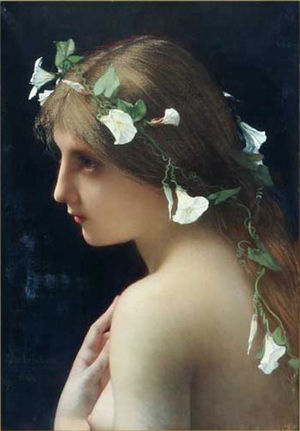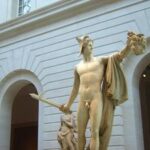In Greek mythology, nymphs are nature goddesses of lower rank, who are attached to the location they live in, e.g. a tree, a river, a lake, a spring, a mountain, a rock, etc. In a sense, they are like the genius loci (= guardian spirit of a place) of Roman mythology, or the fairies of Western European folklore.
Throughout classical mythology, references to nymphs are numerous, but not always compatible. Here are some fun trivia about these magical creatures of Greek myth:
The word nymph means “bride” (cf. Latin nupta > nuptial), but also “any married woman” or “marriageable maiden”. The etymology indicates that nymphs were perceived as nubile girls or young brides.
Furthermore, the word nymph has given us sexually suggestive derivatives, such us nymphet (see Lolita), nymphomania, and nympholepsy. Nympholepsy describes the demonic frenzy of a person that is bewitched and possessed by nymphs. The Romans had an interesting word for that particular craziness: they called it lymphaticum (from lympha = spring or river water). The similarity of lympha with nymph (Greek nympha) is too striking to ignore.
Were nymphs immortal? The ancient sources are not consistent. Nymphs are often called “daughters of Zeus” and “goddesses”, but they do not seem to be immortal like the Olympians. A lot depends on the location they are bound to: Nymphs of the sea (Nereids) and the ocean (Oceanids) are said to be as timeless as the waters they live in. Tree nymphs, on the other hand, such as the Hamadryads, live and die with the tree they protect. Hesiod mentions an ancient formula for calculating the life-span of nymphs: “… crows live nine times as long as men, stags four times as long as crows, ravens three times as long as stags, a phoenix nine times as long as a raven, and the nymphs ten times as long as the phoenix.” (Thorndike, p. 207) According to this formula, nymphs were extraordinarily long-lived, but not immortal.
The names of nymphs denote their place of residence: Alseids (< alsos, a sacred grove) live in groves; Oreads (< oros, hill) are mountain nymphs; Naiads (< nao, to flow) are spring or river nymphs; the Hyades (< huei, it is raining) are rain nymphs, and the Leimoniads (< leimon, meadow) are meadow nymphs. The list could (and does!) go on forever.
In the grand scheme of things, nymphs mostly play supporting roles either as members of a major god’s retinue or as nurses and protectors of baby gods. The nymph Maia is the only nymph to have given birth to an Olympian deity (Hermes). Other famous nymphs include Echo (who was reduced to an echoing voice because she scorned the love of god Pan) and Daphne (who turned into a laurel rather than succumb to the lust of Apollo).
The nine Muses are sometimes referred to as nymphs, especially as water nymphs attached to sacred springs that gush forth divine inspiration.
Sources:
http://en.wikipedia.org/wiki/Greek_mythology
http://www.pantheon.org/areas/mythology/europe/greek/articles.html
A History of Magic and Experimental Science During the First Thirteen Centuries of our Era by Lynn Thorndike. 2 volumes (New York: Macmillan, 1923): http://alturl.com/4qhv





